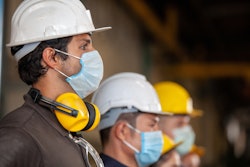
Sixty-four percent of highway contractors report that motor vehicles had crashed into their construction work zones during the past year, putting motorists and workers at risk, according to the results of a new highway work zone study conducted by the Associated General Contractors of America and HCSS. In response, officials urged drivers to slow down and remain alert while passing through work zones during the summer driving season.
“The men and women of the construction industry are frequently working just a few feet, and sometimes inches, away from speeding vehicles,” said Ken Simonson, the association’s chief economist and author of the annual survey. “Drivers who are too often distracted, speeding and/or under-the-influence crash into those work zones, putting workers and themselves at risk of serious harm and death.”
According to the survey results, motorists are in even greater danger from highway work zone crashes than construction workers, Simonson noted. Eighteen percent of contractors participating in the survey experienced crashes that resulted in injury to construction workers. But more than twice as many firms–41 percent—reported experiencing a crash in which drivers or passengers were injured.
Drivers and passengers also are twice as likely as construction workers to be killed in work zone crashes. Seven percent of contractors in the survey report that construction workers were killed in work zone crashes, while 15 percent of survey respondents report drivers or passengers were killed in those crashes.
“In many cases, vehicle speeding contributes to these crashes in work zones,” said Steve McGough, President and CEO of HCSS. “Utilizing speed cameras with a zero-tolerance policy would go a long way to protect the traveling public and our workforce.”
Simonson noted that 97 percent of contractors report that highway work zones are either as dangerous, or more dangerous, than they were a year ago. He said that figure is consistent with newly released federal data that reported motor vehicle fatalities rose to a 17-year high in 2021.
The economist added that construction firms are taking steps to improve work zone safety, through special training programs, new technology and software made available by firms like HCSS. He added that public officials need to take steps to better protect highway work zones, by boosting police presence and enacting tougher laws and penalties for drivers using their cell phones, for example.
Simonson added that the association was urging motorists, particularly those heading out for summer vacations, to be careful when passing through highway work zones. And the association is releasing a new public service video highlighting the story of a young worker who was killed by a distracted driver. “The best thing anyone can do to protect themselves and workers is to slow down, put the phone away, and pay attention when they are in a highway work zone,” Simonson urged.
The work zone safety study was based on a nationwide survey of highway construction firms the association conducted this April and May. Over 500 contractors completed the survey. Click here to view the survey results.
Safety Beyond the Barrels
We can do everything possible to keep our workers safe, but the traveling public also has to do their part. Work zone safety really is everyone’s responsibility. It takes contractors, engineers and traffic control plan supervisors to properly plan and design the work zones; flaggers to guide the public through the work zones; drivers, cyclists and pedestrians to remain alert and pay attention while entering and driving through the work zones; and local and state government, area police and emergency responders to help ensure that everyone goes home safe at the end of the day.
Here are some things we need to consider:
- Devices such as attenuators and rumble strips can be used to alert motorists to upcoming work zones
- Automatic flagging devices: If there are ever opportunities to keep workers off the road, like with automatic flagging devices, your company should take advantage.
- Effective signage, even those that appeal to the emotions of drivers, can also help keep drivers alert that there are workers ahead.
- When possible, work zones should build law enforcement protection in to the bid. This is considered one of the most effective for controlling driver behavior in work zones. Make sure they are positioned correctly to provide the best protection possible.
- Some states have also started to deploy automatic speed enforcement in work zones which is another very effective way to keep motorists from speeding through work zones.



















